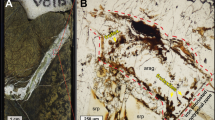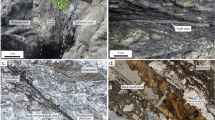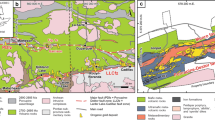Abstract
The section of the San Andreas fault located between Cholame Valley and San Juan Bautista in central California creeps at a rate as high as 28 mm yr-1 (ref. 1), and it is also the segment that yields the best evidence for being a weak fault embedded in a strong crust2,3,4,5. Serpentinized ultramafic rocks have been associated with creeping faults in central and northern California6,7,8, and serpentinite is commonly invoked as the cause of the creep and the low strength of this section of the San Andreas fault. However, the frictional strengths of serpentine minerals are too high to satisfy the limitations on fault strength, and these minerals also have the potential for unstable slip under some conditions9,10. Here we report the discovery of talc in cuttings of serpentinite collected from the probable active trace of the San Andreas fault that was intersected during drilling of the San Andreas Fault Observatory at Depth (SAFOD) main hole in 2005. We infer that the talc is forming as a result of the reaction of serpentine minerals with silica-saturated hydrothermal fluids that migrate up the fault zone, and the talc commonly occurs in sheared serpentinite. This discovery is significant, as the frictional strength of talc at elevated temperatures is sufficiently low to meet the constraints on the shear strength of the fault, and its inherently stable sliding behaviour is consistent with fault creep11. Talc may therefore provide the connection between serpentinite and creep in the San Andreas fault, if shear at depth can become localized along a talc-rich principal-slip surface within serpentinite entrained in the fault zone.
This is a preview of subscription content, access via your institution
Access options
Subscribe to this journal
Receive 51 print issues and online access
$199.00 per year
only $3.90 per issue
Buy this article
- Purchase on Springer Link
- Instant access to full article PDF
Prices may be subject to local taxes which are calculated during checkout



Similar content being viewed by others
References
Titus, S. J., DeMets, C. & Tikoff, B. Thirty-five-year creep rates for the creeping segment of the San Andreas fault and the effects of the 2004 Parkfield earthquake: Constraints from alignment arrays, continuous global positioning system, and creepmeters. Bull. Seismol. Soc. Am. 96, (4B)S250–S268 (2006)
Provost, A.-S. & Houston, H. Orientation of the stress field surrounding the creeping section of the San Andreas fault: Evidence for a narrow mechanically weak fault zone. J. Geophys. Res. 106, 11373–11386 (2001)
Hickman, S. & Zoback, M. Stress orientations and magnitudes in the SAFOD pilot hole. Geophys. Res. Lett. 31 L15S12 doi: 10.1029/2004GL020043 (2004)
Chéry, J., Zoback, M. D. & Hickman, S. A mechanical model of the San Andreas fault and SAFOD Pilot Hole stress measurements. Geophys. Res. Lett. 31 L15S13 doi: 10.1029/2004GL019521 (2004)
Williams, C. F., Grubb, F. V. & Galanis, S. P. Heat flow in the SAFOD pilot hole and implications for the strength of the San Andreas Fault. Geophys. Res. Lett. 31 L15S14 doi: 10.1029/2003GL019352 (2004)
Allen, C. R. in Proc. Conf. on Geologic Problems of San Andreas Fault System (eds Dickinson, W. R. & Grantz, A.) 70–80 (Stanford University Publications in the Geological Sciences Vol. 11, Stanford University, Stanford, California, 1968)
Hanna, W. F., Brown, R. D., Ross, D. C. & Griscom, A. Aeromagnetic reconnaissance and generalized geologic map of the San Andreas fault between San Francisco and San Bernardino, California. US Geol. Surv. Geophys. Investig. Map GP-815 (1972)
Irwin, W. P. & Barnes, I. Effect of geologic structure and metamorphic fluids on seismic behavior of the San Andreas fault system in central and northern California. Geology 3, 713–716 (1975)
Moore, D. E., Lockner, D. A., Ma, S., Summers, R. & Byerlee, J. D. Strengths of serpentinite gouges at elevated temperatures. J. Geophys. Res. 102, 14787–14801 (1997)
Moore, D. E., Lockner, D. A., Tanaka, H. & Iwata, K. in Serpentine and Serpentinites: Mineralogy, Petrology, Geochemistry, Ecology, Geophysics, and Tectonics (ed. Ernst, W.G.) 525–538 (International Book Series Vol. 8, Geological Society of America, Boulder, Colorado, 2004)
Moore, D. E. & Lockner, D. A. Comparative deformation behavior of minerals in serpentinized ultramafic rock: Application to the slab-mantle interface in subduction zones. Int. Geol. Rev. 49, 401–415 (2007)
Zoback, M. D., Hickman, S. & Ellsworth, W. Overview of SAFOD Phases 1 and 2: Drilling, sampling and measurements of the San Andreas Fault zone at seismogenic depth. Eos 86 (Fall Meet. Suppl.), abstr. T23E–01. (2005)
Williams, C. F., Grubb, F. V. & Galanis, S. P. Heat-flow measurements across the San Andreas fault near Parkfield, California — Preliminary results from SAFOD. Eos 87(Fall Meet. Suppl.), abstr. S33B–0241. (2006)
Solum, J. G. et al. Mineralogical characterization of protolith and fault rocks from the SAFOD main hole. Geophys. Res. Lett. 33 L21314 doi: 10.1029/2006GL027285 (2006)
McPhee, D. K., Jachens, R. C. & Wentworth, C. M. Crustal structure across the San Andreas Fault at the SAFOD site from potential field and geologic studies. Geophys. Res. Lett. 31 L12S03 doi: 10.1029/2003GL019363 (2004)
Coleman, R. G. Petrologic and geophysical nature of serpentinites. Geol. Soc. Am. Bull. 82, 897–918 (1971)
Dickinson, W. R. Table Mountain serpentinite extrusion in California Coast Ranges. Geol. Soc. Am. Bull. 77, 451–472 (1966)
Rymer, M. J. Geologic map along a 12 kilometer segment of the San Andreas fault zone, southern Diablo Range, California (scale 1:12,000). US Geol. Surv. Open-File Rep. 81–1173 (1981)
Rymer, M. J. et al. Surface fault slip associated with the 2004 Parkfield, California, earthquake. Bull. Seismol. Soc. Am. 96, (4B)S11–S27 (2006)
Robbins, S. L. Complete Bouguer gravity, aeromagnetic, and generalized geologic map of the Hollister 15-minute quadrangle, California (scale 1:62,500). US Geol. Surv. Geophys. Investig. Map GP-945 (1982)
Galehouse, J. S. & Lienkaemper, J. J. Inferences drawn from two decades of alinement array measurements of creep on faults in the San Francisco Bay region. Bull. Seismol. Soc. Am. 93, 2415–2433 (2003)
Brune, J. N., Henyey, T. L. & Roy, R. F. Heat flow, stress and rate of slip along the San Andreas fault, California. J. Geophys. Res. 74, 3821–3827 (1969)
Lachenbruch, A. H. & Sass, J. H. Heat flow and energetics of the San Andreas fault zone. J. Geophys. Res. 85, 6185–6223 (1980)
Mount, V. S. & Suppe, J. State of stress near the San Andreas fault: Implications for wrench tectonics. Geology 15, 1143–1146 (1987)
Zoback, M. D. et al. New evidence for the state of stress on the San Andreas fault system. Science 238, 1105–1111 (1987)
Blanpied, M. L., Lockner, D. A. & Byerlee, J. D. Frictional slip of granite at hydrothermal conditions. J. Geophys. Res. 100, 13045–13064 (1995)
Evans, B. W. & Guggenheim, S. in Hydrous Phyllosilicates (Exclusive of Micas) (ed. Bailey, S.W.) 225–294 (Reviews in Mineralogy Vol. 19, Mineralogical Society of America, Washington DC, 1988)
Moore, D. E. & Lockner, D. A. Crystallographic controls on the frictional behavior of dry and water-saturated sheet structure minerals. J. Geophys. Res. 109 B03401 doi: 10.1029/2003JB002582 (2004)
Inoue, A. & Utada, M. Smectite-to-chlorite transformation in thermally metamorphosed volcaniclastic rocks in the Kamikita area, northern Honshu, Japan. Am. Mineral. 76, 628–640 (1991)
Chester, F. M. & Chester, J. S. Ultracataclasite structure and friction processes of the Punchbowl fault, San Andreas system, California. Tectonophysics 295, 199–221 (1998)
Author information
Authors and Affiliations
Corresponding author
Ethics declarations
Competing interests
Reprints and permissions information is available at www.nature.com/reprints. The authors declare no competing financial interests.
Supplementary information
Supplementary Information
This file contains a Supplementary Figure 1 showing the relative positions of features of the active trace in the SAFOD drillhole and a Supplementary Table 1 of representative compositions of talc, serpentine, and saponite obtained by electron microprobe techniques. (PDF 196 kb)
Rights and permissions
About this article
Cite this article
Moore, D., Rymer, M. Talc-bearing serpentinite and the creeping section of the San Andreas fault. Nature 448, 795–797 (2007). https://doi.org/10.1038/nature06064
Received:
Accepted:
Published:
Issue Date:
DOI: https://doi.org/10.1038/nature06064
This article is cited by
-
Si- versus Mg-metasomatism at the crust–mantle interface: insights from experiments, natural observations and geochemical modeling
Progress in Earth and Planetary Science (2023)
-
Geochemical and remote sensing integrated with satellite gravity data of Darhib and Atshan talc deposits, South Eastern Desert, Egypt
Scientific Reports (2023)
-
Physical state of water controls friction of gabbro-built faults
Nature Communications (2023)
-
Origin and Evolution of Ultramafic Rocks along the Sagaing Fault, Myanmar
Journal of Earth Science (2023)
-
A new type of sliding zone soil and its severe effect on the formation of giant landslides in the Jinsha River tectonic suture zone, China
Natural Hazards (2023)
Comments
By submitting a comment you agree to abide by our Terms and Community Guidelines. If you find something abusive or that does not comply with our terms or guidelines please flag it as inappropriate.



